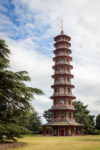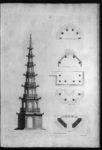 The Great Pagoda at Kew Gardens is in the midst of a major restoration project that will return it to its original glory. This is a tall order, no pun intended, for a wooden octagonal tower ten stories high that was built in 1762. Towering 50 meters (164 feet) above London, the Great Pagoda was unique for its time with its height, Chinese-inspired design and spectacular bird’s eye view of the city. It was the highest Chinese-style building in Europe. A great many people doubted that so tall and thin a structure could even survive and expected it to fall down at any moment. Not everyone would have been unhappy with that outcome, mind you. Horace Walpole, antiquarian, author and son of Prime Minister Robert Walpole, disliked it immensely. He complained in correspondence with a friend that he could see it from his Strawberry Hill House, his Gothic estate in Twickenham, and that if it kept on like this, soon it could be seen from Yorkshire.
The Great Pagoda at Kew Gardens is in the midst of a major restoration project that will return it to its original glory. This is a tall order, no pun intended, for a wooden octagonal tower ten stories high that was built in 1762. Towering 50 meters (164 feet) above London, the Great Pagoda was unique for its time with its height, Chinese-inspired design and spectacular bird’s eye view of the city. It was the highest Chinese-style building in Europe. A great many people doubted that so tall and thin a structure could even survive and expected it to fall down at any moment. Not everyone would have been unhappy with that outcome, mind you. Horace Walpole, antiquarian, author and son of Prime Minister Robert Walpole, disliked it immensely. He complained in correspondence with a friend that he could see it from his Strawberry Hill House, his Gothic estate in Twickenham, and that if it kept on like this, soon it could be seen from Yorkshire.
Kew Gardens wasn’t the national botanical garden then that it is now. That didn’t happen until 1840. It started out as a private garden with a collection of exotic plants created by Lord Capel John of Tewkesbury on the grounds of Kew Park near Richmond Palace. After the 1751 death of Frederick, Prince of Wales, heir to the throne and father of the future King George III, his wife Augusta, Dowager Princess of Wales, greatly expanded the little exotic garden. She commissioned architect Sir William Chambers, a favorite of John Stuart, 3rd Earl of Bute, Augusta’s closest advisor (some said lover, some Svengali), to design several new structures and follies for Kew Gardens. Over the decades he built the Gallery of Antiquities (now demolished), the Temple of Pan (demolished), the Temple of the Sun (demolished), and still standing today, the Ruined Arch, the Temple of Bellona, the Temple of Aeolus, the Orangery and the Great Pagoda.
 Chambers was uniquely suited to that last task. Born in Sweden to a Scottish merchant, he had worked for the Swedish East India Company for almost a decade starting when he was 17 years old. While in its employ, Chambers went to China three times and dedicated himself to the study of Chinese architecture. When he came back to Europe for good, he chose to pursue architecture, studying with masters in Paris and Italy before opening starting his own firm in London in 1755. Just two years later, thanks to John Stuart, he had made the big time garnering an appointment as tutor in architecture to the Prince of Wales. That same year he published a book about Chinese architecture that made a huge splash and popularized Chinese style in design, fashion and the decorative arts. His list of subscribers might as well have been Debrett’s Peerage — His Royal Highness the Prince of Wales, Her Royal Highness the Princess Dowager of Wales, His Royal Highness the Duke, and a few rungs down on the ladder, the Earl of Bute.
Chambers was uniquely suited to that last task. Born in Sweden to a Scottish merchant, he had worked for the Swedish East India Company for almost a decade starting when he was 17 years old. While in its employ, Chambers went to China three times and dedicated himself to the study of Chinese architecture. When he came back to Europe for good, he chose to pursue architecture, studying with masters in Paris and Italy before opening starting his own firm in London in 1755. Just two years later, thanks to John Stuart, he had made the big time garnering an appointment as tutor in architecture to the Prince of Wales. That same year he published a book about Chinese architecture that made a huge splash and popularized Chinese style in design, fashion and the decorative arts. His list of subscribers might as well have been Debrett’s Peerage — His Royal Highness the Prince of Wales, Her Royal Highness the Princess Dowager of Wales, His Royal Highness the Duke, and a few rungs down on the ladder, the Earl of Bute.
Here’s how he described Chinese towers in Designs of Chinese Buildings, Furniture, Dresses, Machines, and Utensils:
The towers called by the Chinese Taa, and which the Europeans call likewise pagodas, are very common in China. In some provinces, says Du Halde, you find them in every town, and even in the large villages. The most considerable of them all are the famous porcelain-tower at Nang-Kingj, and that of Tong-Tchang-Fou, both of which are very magnificent structures.
In regard to their form, the Taas are all nearly alike being of an octagonal figure, and consisting of seven, eight, and sometimes ten stories, which grow gradually less both in height and breadth all the way from the bottom to the top. Each story is finished with a kind of cornish, that supports a roof, at the angles of which hang little brass bells ; and round each story runs a narrow gallery, inclosed by a rail or balustrade. These buildings commonly terminate in a long pole, surrounded with several circles of iron, hanging by eight chains fixed to the top of the pole, and to the angles of the covering of the last story.
 He began construction on the Great Pagoda at Kew Gardens in 1761, four years after the book was published. Chambers followed the template he’d written about in his book to the letter, using the Porcelain Tower of Nanjing as his model. He went for the most ambitious goal referenced in his book, the ten story tower, even though in reality Chinese towers have uneven numbers of floors, seven ideally. Each floor he made just 30 cm (12 inches) narrower than the one underneath it. It was also a riot of color originally. The roofs were tiled with varnished iron plates and had a dragon perched on each corner. The dragons were hand-carved out of wood and gilded. Over time the varnished iron roof tiles were replaced with slate and the dragons were removed in 1784 during roof repairs. Nobody knows for sure what became of them. Gossip has it that they were sold to pay King George IV’s gambling debts, but they weren’t made out of solid gold and you can’t really hock gilded wood dragons. The true story, confirmed by at least one contemporary, is probably more mundane than that: they were simply neglected and rotted away.
He began construction on the Great Pagoda at Kew Gardens in 1761, four years after the book was published. Chambers followed the template he’d written about in his book to the letter, using the Porcelain Tower of Nanjing as his model. He went for the most ambitious goal referenced in his book, the ten story tower, even though in reality Chinese towers have uneven numbers of floors, seven ideally. Each floor he made just 30 cm (12 inches) narrower than the one underneath it. It was also a riot of color originally. The roofs were tiled with varnished iron plates and had a dragon perched on each corner. The dragons were hand-carved out of wood and gilded. Over time the varnished iron roof tiles were replaced with slate and the dragons were removed in 1784 during roof repairs. Nobody knows for sure what became of them. Gossip has it that they were sold to pay King George IV’s gambling debts, but they weren’t made out of solid gold and you can’t really hock gilded wood dragons. The true story, confirmed by at least one contemporary, is probably more mundane than that: they were simply neglected and rotted away.
 Architect Decimus Burton, a botanical enthusiast as well as one of the leading architects of the Greek Revival, Regency and Georgian styles, proposed a restoration of the Great Pagoda to its original splendour, but he was denied on the grounds that the sum of £4,350 it would require was just too princely. Piecemeal restorations have taken place since, mainly to the roofs — holes were cut in each floor during World War II so British bomb designers could test the trajectories and movements of their bombs when dropped — and while there was some talk of going for a larger magnitude reconstruction that would include replica dragons, nothing came of it for decades.
Architect Decimus Burton, a botanical enthusiast as well as one of the leading architects of the Greek Revival, Regency and Georgian styles, proposed a restoration of the Great Pagoda to its original splendour, but he was denied on the grounds that the sum of £4,350 it would require was just too princely. Piecemeal restorations have taken place since, mainly to the roofs — holes were cut in each floor during World War II so British bomb designers could test the trajectories and movements of their bombs when dropped — and while there was some talk of going for a larger magnitude reconstruction that would include replica dragons, nothing came of it for decades.
Except for a brief window in 2006, the tower has been closed to the public. That sad loss is soon to be remedied, however, because the ambitious restoration is scheduled to be completed and the Great Pagoda reopened in all its iridescent 18th century glory come spring of 2018. And yes, there will be dragons. All 80 of them are going back to their respective corners. The eight dragons on the first roof will be carved by hand out of wood, just like the originals. The ones on the higher story will be more workmanlike, made out of nylon on 3D printers and virtually indestructible.
Technology can only help so much. This is not a relatively simple matter of creating an exact copy of an existing object. Not only were all the dragons long gone decades before Louis Daguerre took that first picture of a Parisian street, but they aren’t even any extant depictions of the dragons. Curators have had to rely on archival resources and research into the Chinoiserie style of the period to recreate the carving and paint colors. See them at work in these fantastic(al) videos:
If old Horace were selling his property today, being able to see the pagoda would be a feature.